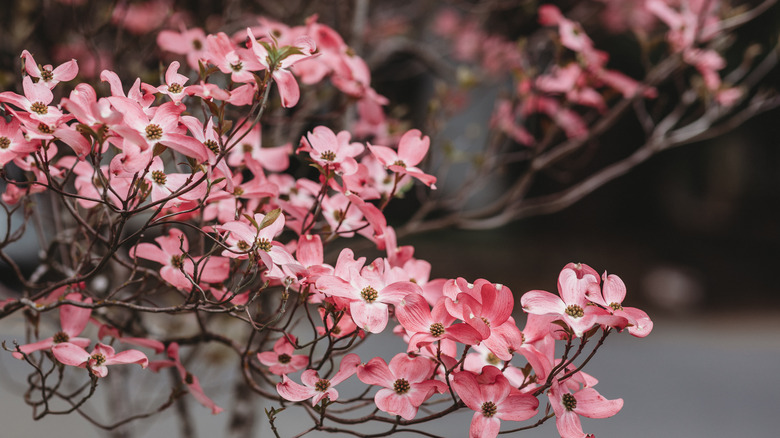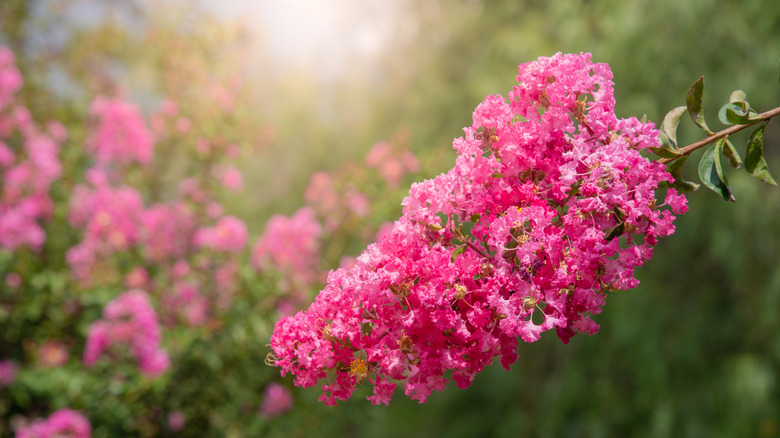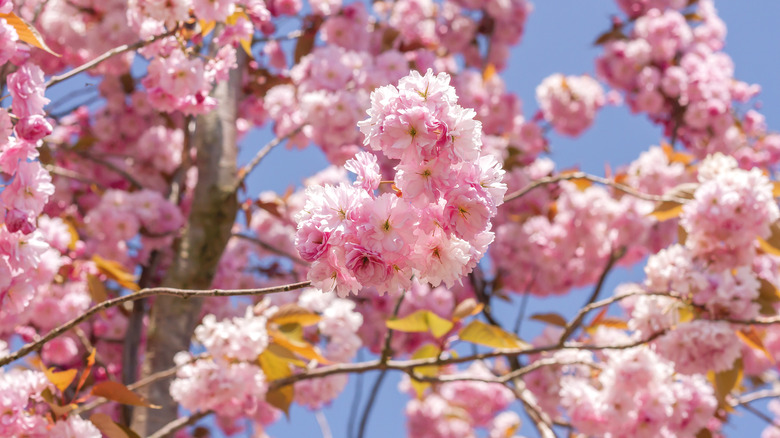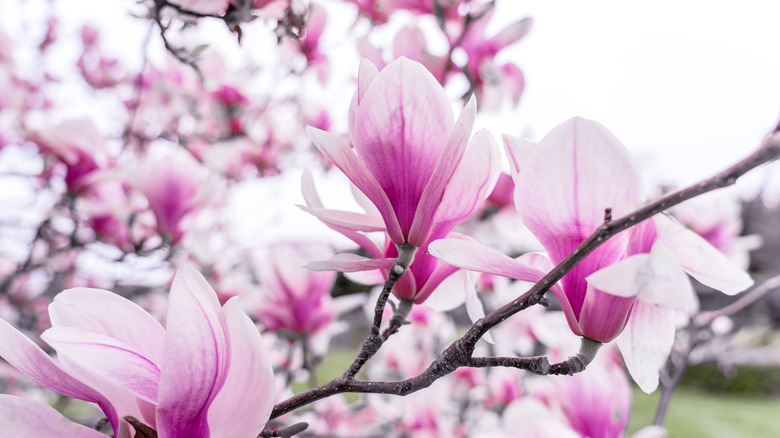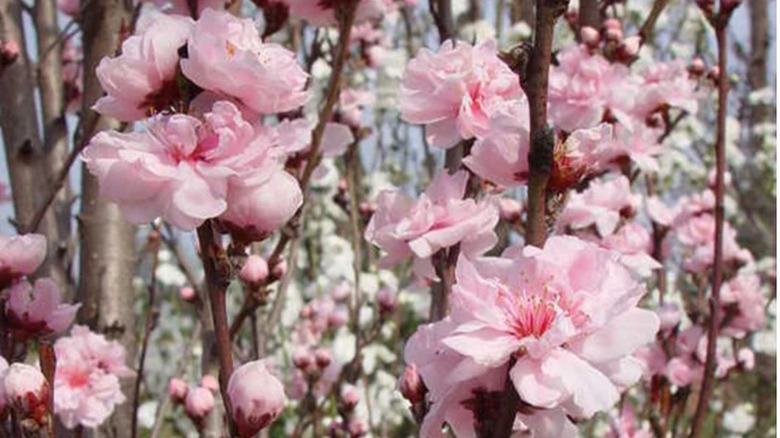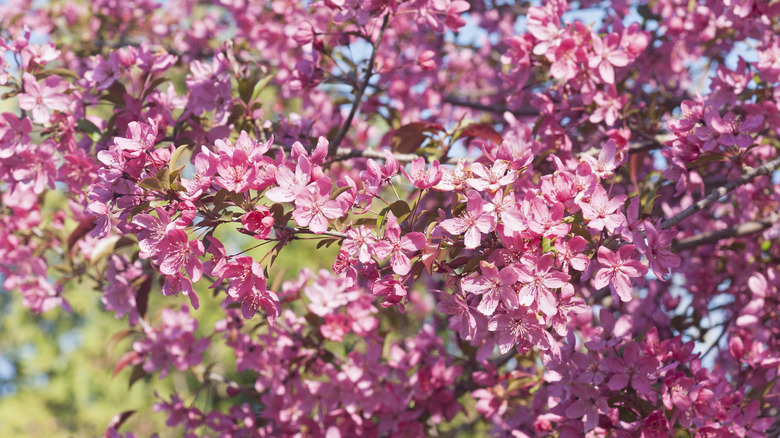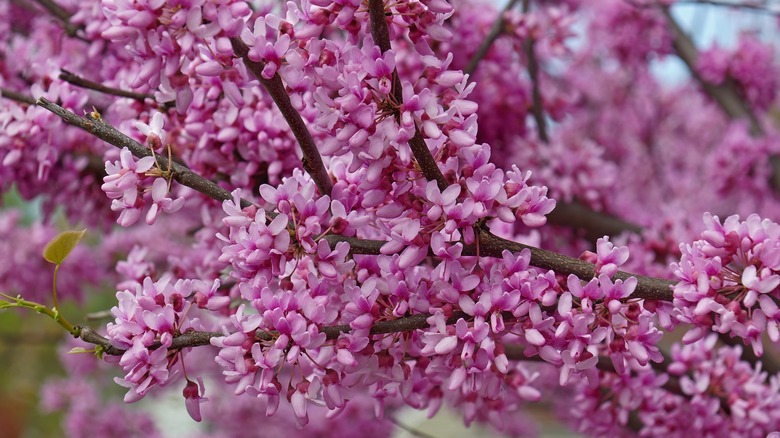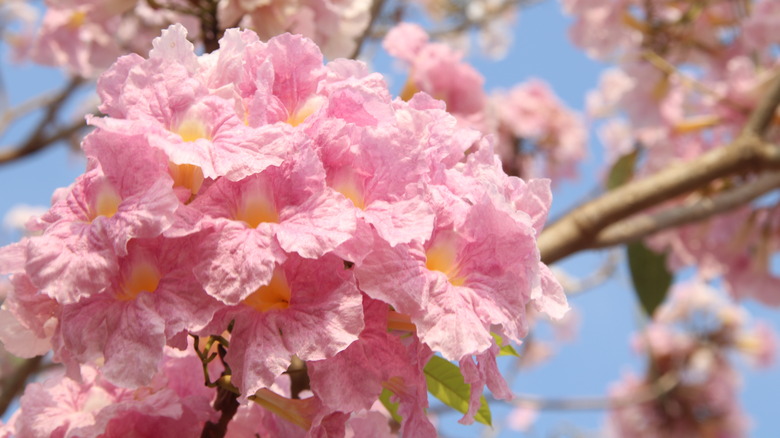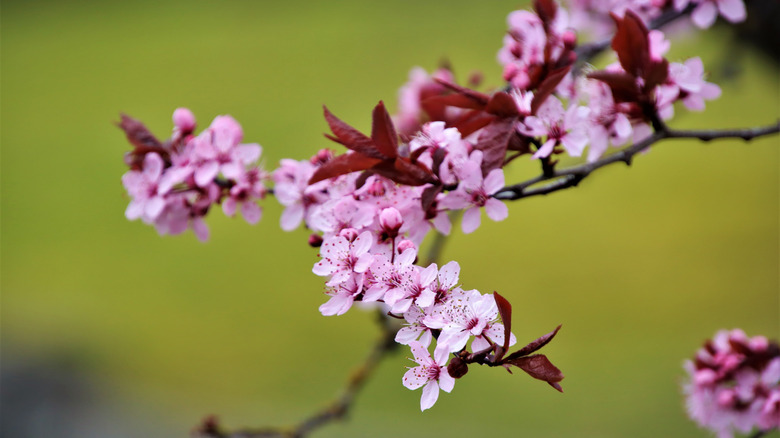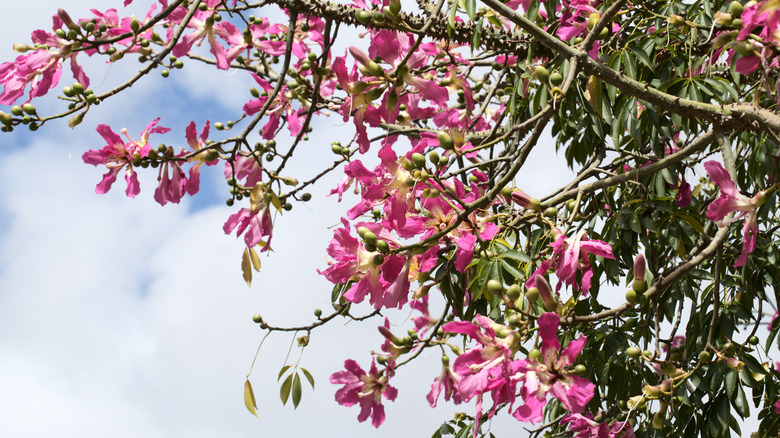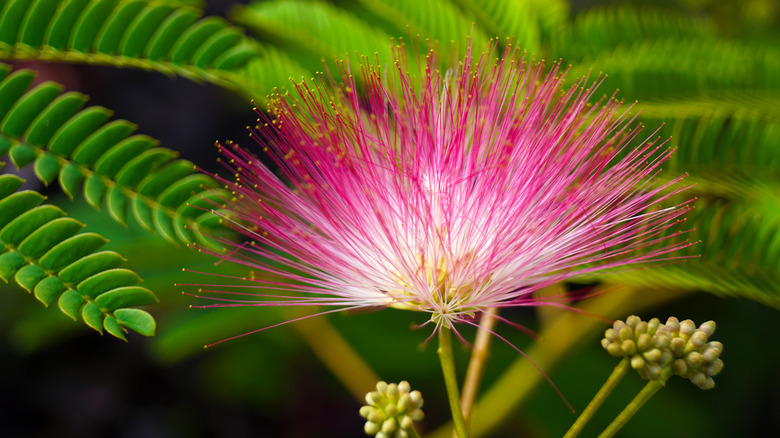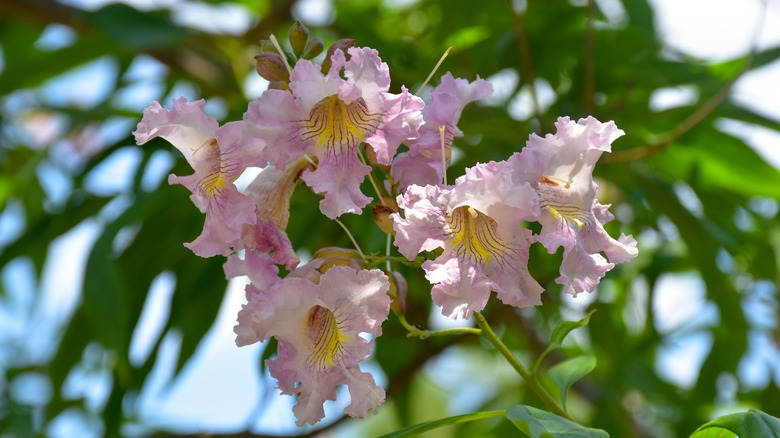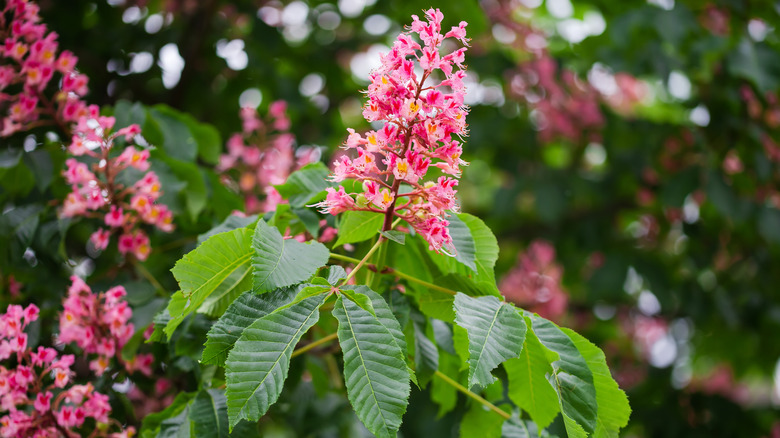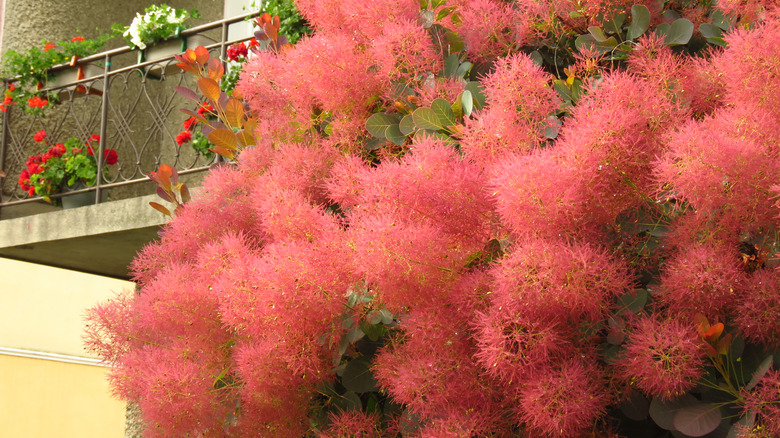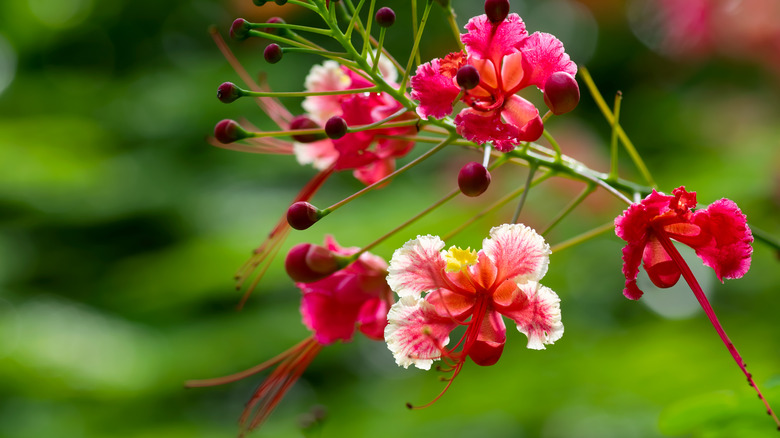15 Trees With Pink Flowers You Should Have In Your Yard
During the late winter to the early spring season, something exciting and special happens when you pop your head outside and see little pink buds start to flower on the trees in your neighborhood. You know when they fully bloom, it is going to look spectacular.
Pink flowering trees are a beautiful addition to any landscape. They add color and life to an area, and their petals can be enjoyed up close by both us as well as butterflies and hummingbirds, too. There are many different types of pink flowering trees, and they come in a variety of shapes and sizes.
Pink flowering trees are easy to care for and can thrive in a variety of climates. They typically bloom in the springtime, but some varieties can also bloom in the fall. Their blooms can last for several weeks, depending on the type of tree, per FastGrowingTrees.com.
If you're looking for a beautiful addition to your landscape that will provide color all year long, then consider planting a pink flowering tree.
1. Pink dogwood tree
The pink dogwood tree (Cornus florida var. rubr) is a beautiful addition to any landscape. The leaves are green and oval-shaped, and the flowers are a gorgeous shade of pink. The tree blossoms with bright pink petals during April and May, and the flowers are a favorite of bees and other pollinators. In the fall, the leaves turn a lovely shade of red. Arbor Day Foundation notes that the Pink Dogwood tree is a very popular pink tree to plant in the United States and makes great trees to plant near a patio or next to buildings.
Bloom Season: Early spring
USDA Growing Zone: 5 to 9
Growing Conditions: Partial to full sun
Soil Type: Loamy, sand-like well-drained soil
Size: Can grow 15 to 25 feet tall with a spread of 25 feet when mature
2. Crape Myrtle
With its extremely vibrant blooms, the Crepe Myrtle tree (Lagerstroemia indica) is a flower that shares its blooms with us during the summer months. McDonald Garden Center notes that it is also very heat tolerant. It is known as the "tree of 100 days" due to its long period of blooming. There are small shrub-like varieties along with taller varieties as well. The flower received its name from the tiny pink flowers that blossom as crinkled little blooms, similar to the texture of crepe paper. These are extremely hardy trees, per Garden Design.
Bloom Season: Early summer through fall
USDA Growing Zone: 6 to 10
Growing Conditions: Full sun
Soil Type: Well-drained, sandy, clay
Size: Can grow to 25 feet
3. Kwanzan cherry tree
The Kwanzan cherry tree (Prunus serrulata 'Kwanzan') is an ornamental cherry tree that is known for its beautiful pink flowers. The double blooms appear in clusters and can be quite stunning against the branches of the tree. Kwanzan cherry trees are deciduous, meaning they lose their leaves in the autumn. They are a popular choice for gardens and landscapes, as well as for use in large planters on city streets. According to Tree Journey, they are a flowering tree that is rather low maintenance, so you don't have to worry about it too much.
Bloom Season: Early spring
USDA Growing Zone: 4 to 6
Growing Conditions: Full sun
Soil Type: Wet, clay, loamy, and sandy soil
Size: Can grow to 30 to 40 feet
4. Jane Magnolia
The Jane Magnolia tree (Magnolia x 'Jane') is a beautiful pink flowering tree. It is also a deciduous tree with lightly fragrant flowers that can grow 6 inches across. They are native to the eastern United States but can also be found in other parts of the world. As Nature Hills states, these trees are pretty hardy, especially with the fuzz that covers up the buds are able to protect the tree from frost before it is time for them to bloom.
Bloom Season: Late spring
USDA Growing Zone: 4 to 8
Growing Conditions: Full sun with partial shade
Soil Type: Moist, well-drained soil
Size: Can grow to 10 to 15 feet
5. Corinthian Rose Double Flowering Peach Tree
The Corinthian Rose Double Flowering Peach tree (Prunus persica 'Corinthian Rose') is a pink flowering tree that produces beautiful double blooms, similar to the Kwanzan cherry tree. This peach tree is a great addition to any garden and is perfect for those who are looking for something different or an attractive landscape feature. New Garden notes that the colorful flowers are very fragrant when they bloom. The Corinthian Rose Double Flowering Peach Tree is a hardy tree that is resistant to disease, and it will thrive in most climates.
Bloom Season: Late spring
USDA Growing Zone: 5 to 9
Growing Conditions: Full sun
Soil Type: Well-drained soil, avoid overly watering
Size: Can grow to 25 feet
6. Prairifire Crabapple Tree
The Prairifire Crabapple tree (Malus 'Prairifire') is a deciduous tree that does not get diseased easily, according to Gardenia. It is noted for its showy, pink flowers that appear in mid-spring before the leaves. The flowers are followed by edible fruit that is enjoyed by birds and other wildlife and can even be made into jams. This tree is adaptable to a wide range of soils and climates and is drought-tolerant.
Bloom Season: Mid-spring
USDA Growing Zone: 4 to 8
Growing Conditions: Full sun
Soil Type: Chalky, loamy, or sandy soil
Size: Can grow to 20 feet
7. Oklahoma redbud tree
The Oklahoma redbud tree (Cercis reniformis 'Oklahoma') is a small understory landscaping tree. It is noted for its hot pink flowers, which appear in early spring before the leaves emerge. The flowers are loved by bees, birds, and other pollinators. According to Monrovia, the deep pink blooms will give way to gorgeous purple pods later on in the season.
Bloom Season: Early spring
USDA Growing Zone: 6 to 9
Growing Conditions: Full sun or partial shade
Soil Type: Moist, clay, well-drained soil
Size: Can grow to 15 feet
8. Pink trumpet tree
The Pink trumpet tree (Tabebuia impetiginosa) is a beautiful flowering tree that blooms with delicate pink flowers. The tree is rather tall and makes an excellent addition to any garden or landscape and provides shade when in bloom. Water Wise Garden Planner notes that the tree is originally from Central and South America, meaning it grows great in warmer climates. The pink trumpet tree blooms are highly attractive to butterflies, bees, and more. The tree is also drought tolerant and resistant to pests and diseases, making it a great choice for areas with limited water resources.
Bloom Season: Spring through summer
USDA Growing Zone: 10 to 11 (via University of Redlands)
Growing Conditions: Full to partial sun
Soil Type: Clay, sand, well-drained
Size: Can grow to 30 to 40 feet
9. KV Flowering Plum Tree
The KV Flowering Plum tree (Prunus cerasefera 'Krauter Vesuvius') is a lovely tree that can be used in landscapes as a lone tree or for hedges or screens as well. It blooms early in the springtime with beautiful bursts of pink flowers. This flowering plum tree variety is also known for its gorgeous deep purple leaves, which arrive after the flowers, according to Gardenia. They also produce little edible fruits, which tend to attract birds, bees, and butterflies.
Bloom Season: Spring
USDA Growing Zone: 5 to 8
Growing Conditions: Full to partial sun
Soil Type: Clay, chalky, loamy, sandy
Size: Can grow to 20 feet
10. Pink Silk Floss Tree
The Pink Silk Floss tree (Chorisia (ceiba) speciosa) is a tropical plant that produces pink blooms that look quite similar to hibiscus blossoms. These are tall and fast-growing trees, making them a popular choice for large yards. The pink silk floss tree grows best in areas with warmer climates and can be used as a shade tree or street tree. According to Top Tropicals, once the blooms disappear, seed pods will grow and are filled with a soft white cotton-like fiber called Kapok.
Bloom Season: October to November
USDA Growing Zone: 9 to 11 (via FastGrowingTrees.com)
Growing Conditions: Full to partial sun
Soil Type: Moisture-rich, well-drained
Size: Can grow to 40 feet
11. Pink mimosa tree
The pom-pom-like blooms of the pink mimosa tree (Albizia julibrissin) are fragrant and make a lovely addition that will attract butterflies, hummingbirds, and bees alike. This fast-growing tree is drought tolerant once it has been planted and is easy to care for, making it a popular choice for gardeners. The delicate pink blooms appear in late spring and early summer. The Missouri Department of Conservation notes that it is actually in the bean family.
Bloom Season: May to August
USDA Growing Zone: 6 to 10 (via PlantingTree.com)
Growing Conditions: Full sun
Soil Type: Moisture-rich, well-drained, loamy
Size: Can grow to 30 feet
12. Desert willow tree
The desert willow tree (Chilopsis linearis) is a pink flowering tree that can be found in the southwestern United States and northwestern Mexico. This small tree has fragrant foliage and beautiful flowers that can range in color from pale pink to deep purple. The desert willow is a popular ornamental tree and is also used for landscaping and erosion control. According to Calscape, despite being called a willow tree, this deciduous tree is actually a part of the bignonia family.
Bloom Season: May to August
USDA Growing Zone: 7 to 9 (via Arbor Day Foundation)
Growing Conditions: Full sun
Soil Type: Sandy, well-drained, loamy soil
Size: Can grow to 25 feet
13. Red Horse-Chestnut Tree
The Red Horse-Chestnut tree (Aesculus x carnea) is a medium-sized, deciduous tree. This tree is characterized by its loose-clustering pink flowers, which appear in mid-spring to early summer. The leaves are also quite distinctive, as they are deep green with five leaflets that each can grow up to 8 inches long. Gardenia notes that this kind of tree is great for planting in large yards, especially because of how big it can grow to be.
Bloom Season: April to June
USDA Growing Zone: 5 to 8
Growing Conditions: Full sun to partial sun
Soil Type: Moist, well-drained
Size: Typically 15 to 20 feet, but can grow to 40 feet
14. European Smoketree
The European Smoketree (Cotinus coggygria) is a small, deciduous tree with a broadly rounded crown. It is native to central and eastern Europe, where it is found growing in moist woodlands and along stream banks. In North America, it is best grown in gardens, parks, and large yards. European Smoketree is noted for its attractive pink tufts of smoke-like flowers, which appear from mid-spring to late summer. Kalliergeia shares that this tree also can grow well along hedges as well. The leaves are glossy and green, and they turn a beautiful yellow color in the fall.
Bloom Season: April to June
USDA Growing Zone: 5 to 8 (via Arbor Day Foundation)
Growing Conditions: Full sun
Soil Type: Moist, well-drained
Size: Can grow to 15 feet
15. Dwarf poinciana tree
Dwarf poinciana trees (Caesalpinia pulcherrima) are a wonderful choice if you are looking for something that won't get too large. These trees are prized for their ornamental value and are often used as accent trees in landscapes. According to South Florida Plant Guide, this kind of flowering tree will attract butterflies. The tree produces clusters of fragrant flowers that can be red, orange, or yellow in color, though there are also pink flowering varieties. These lovely trees are drought tolerant and relatively easy to care for.
Bloom Season: August to September
USDA Growing Zone: 9 to 10
Growing Conditions: Full sun to partial sun
Soil Type: Sandy, well-drained
Size: Can grow to 10 to 12 feet

